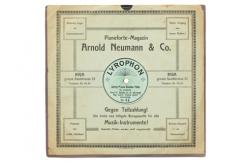




Autor:Bērtiņš Ansis
Researching gramophone records in Latvia, it was established that two Art Nouveau buildings are related to the oldest musical records in Riga. The first is the office building of Helmārs Rudzītis’ record company Bellacord Electro (1931–1944) at 40 Kalnciema Street, designed by the architect Konstantīns Pēkšēns. The building is constructed in the style of National Romanticism with a steep tiled roof (1907–1908). The second building is located at 197 Brīvības Avenue (the present VEF Bank) and was part of the Riga Record Factory (1910–1914) belonging to the English firm Gramophone.
What can be said about music? If Art Nouveau is a visually perceptible art, how did it managed to penetrate the world of music? Music is and remains an art to be heard. Surely, the joy of music can be enhanced with visually attractive performers, an orchestra with many musical instruments, and a lavish stage design for the opera or theatrical performance. Asking whether visual splendour echoed also in the sounds of music, musicologist Jānis Torgāns has looked for the answer in the problems of survival and creativity in the Latvian music of the time, mentioning, for example, some solo songs by Alfrēds Kalniņš from 1902, testifying to the concentration of emotions on a new level.[1] It seems to be rather difficult to establish and specify which composer had created this or that piece under the influence of Art Nouveau ideas. Many compositions created before and after the advent of Art Nouveau in Latvian visual art would need reciprocal comparing.
Quite a few composers emerged on the music scene during the new epoch. Young composers joined the ranks of Latvian culture circles: Alfrēds Kalniņš (1879–1951), Emilis Melngailis (1874–1954), Emīls Dārziņš (1875–1910), Jānis Zālītis (1884–1943), Jānis Reinholds (1882–1938), three brothers with the last name Mediņš: Jāzeps (1877–1947), Jēkabs (1885–1971) and Jānis (1890–1966). Also the older generation composers remained active, such as Ādams Ore (1855–1927), Jurjānu Andrejs (1856–1922), Nikolajs Alunāns (1859–1919), Jāzeps Vītols (1863–1948), Oskars Šepskis (1850–1914), Atis Kauliņš (1867–1944) and other musicians. Surely, composers noticed the new trends in visual art and they considered searching new paths also in the field of composing.
Weitere Informationen werden in der virtuellen Ausstellung, festgelegt wird bis April 2016.
[1] Torgāns, J. “Music in Latvia during the Art Nouveau Period”.In: Jūgendstils: laiks un telpa: Baltijas jūras valstis 19.–20. gs. Mijā = Art Nouveau: Time and Space: The Baltic Sea Countries at the turn of the 20th century. Rīga: Jumava, 1999. P. 282.